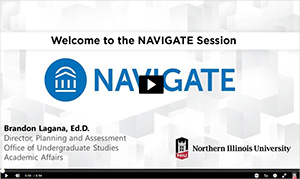- Center for Innovative Teaching and Learning
- Resources
- Toolkits
- Scaffolded Support
- Week Four - Supporting the Disappearing Student

Week Four
Supporting the Disappearing Student
“Some of my students just don’t show up for class” or “How can they learn if they never turn anything in?” – do these thoughts sound familiar? In every semester there are a number of students who receive failing grades not because they performed poorly on assessments, but because they stopped attending class and submitting assignments, or because they never attended. How do we reach these students that are disengaged and unmotivated?
You may want to reflect on your current attendance policies. Although our intention is to encourage active participation and positive behaviors, sometimes attendance polices can decrease students’ sense of autonomy or discourage a student who has fallen behind (Cheneville & Jordan, 2012). Creating a fair and equitable policy balances the importance of attendance and your intention to support their success, with accountability as a member of a thriving learning community. When students don’t respond to your supportive communication, you can also use Navigate to alert the students’ advisers and others who can provide additional support and motivation for the students.
You may wonder why a capable student is not completing easy assignments, or why they avoid gradually more complex assignments. For many students, the fear of their work not being “good enough” is paralyzing. Rather than earn a failing grade from a teacher, they give it to themselves by just not doing the work...Other students ask dozens of questions rather than read the text for information” (Thompson, 2011).
Resources

Supporting Disappearing Students
Every semester, a number of students receive failing grades because they stopped attending class and submitting assignments, or because they never attended. This guide provides recommendations for reaching these missing students.

The Impact of Attendance Polices on Course Attendance among College Students
In this study, Chenneville & Jordan (2012) examined student beliefs about class attendance and the effect of a graded policy on student attendance.

Navigate Introduction and Overview
This video tutorial provides a brief introduction and overview to the features in NIU’s student success and retention platform, Navigate. You can use Navigate to communicate with your students via email and text message and to issue alerts for students who have not responded to you or whose performance has not improved after your guidance.
Recommended Strategies
Choose one of the following strategies to implement
Build Persistence and Confidence
Support students who may be experiencing fear of failure, learned helplessness, or other learning challenges with one of the strategies shared by Thompson (2011), such as:
- Activate prior knowledge when introducing an assignment to increase likelihood of persistence.
- Start a course module with assignments that allow students to be successful before moving to more complex tasks and content to build confidence.
- Use formative assessments to gauge students' progress as they are learning and to provide opportunities for them to improve.
Share Success Tips with Your Students
Take a proactive approach to helping students stay organized and engaged by sharing one or more of the student success tips, including:
- The importance of class attendance
- Staying motivated
- Creating a semester action plan
- Using a calendar or planner
Send Students Text Messages via Navigate
Text messaging students is more effective than emailing for students prone to avoidance (I.e., the “disappearing students” in our classes). Try sending proactive text messages to each student at the beginning of the semester and at key moments during the course.
Issue Alerts for Students Who Need Additional Support
If a student has not been attending class or their progress in the course to this point is unsatisfactory, your first step is to reach out to them directly to offer your assistance, support, and feedback. However, if a student has not responded after multiple attempts or has not improved after your guidance, you can issue an alert via Navigate for additional support. An adviser, a coordinator from Student Athlete Academic Support Services, or staff from the Huskie Academic Support Center will reach out to the student.
Next Steps
Please review the resources and select at least one of the recommended strategies to implement. Make a note to yourself about the strategy you used and the impact that it had.
Next week, we will share resources on Universal Design for Learning (UDL). If you have any questions or concerns in the meantime, feel free to let us know at citl@niu.edu.
 Licensed under a Creative Commons Attribution-NonCommercial-ShareAlike 4.0 International License with the exception of any images, unless specifically noted.
Licensed under a Creative Commons Attribution-NonCommercial-ShareAlike 4.0 International License with the exception of any images, unless specifically noted.
-
Scaffolded Support for Teaching Gateway Courses
-
Creating a Student-Centered Syllabus
-
Starting Strong in the First Week of the Semester
-
Creating (and Sustaining) a Sense of Belonging, Connectedness, and Community
-
Supporting the Disappearing Student
-
Incorporating Universal Design for Learning
-
Connecting Students with Institutional Support Resources
-
Providing Effective Feedback
-
Collecting Mid-semester Feedback
-
Re-energizing Yourself and Your Students
-
Increasing Course Evaluation Response Rates
-
Finishing the Semester on a High Note
-
Bibliography
-
Creating a Student-Centered Syllabus
Contact Us
Center for InnovativeTeaching and Learning
Phone: 815-753-0595
Email: citl@niu.edu
Connect with us on
Facebook page Twitter page YouTube page Instagram page LinkedIn page